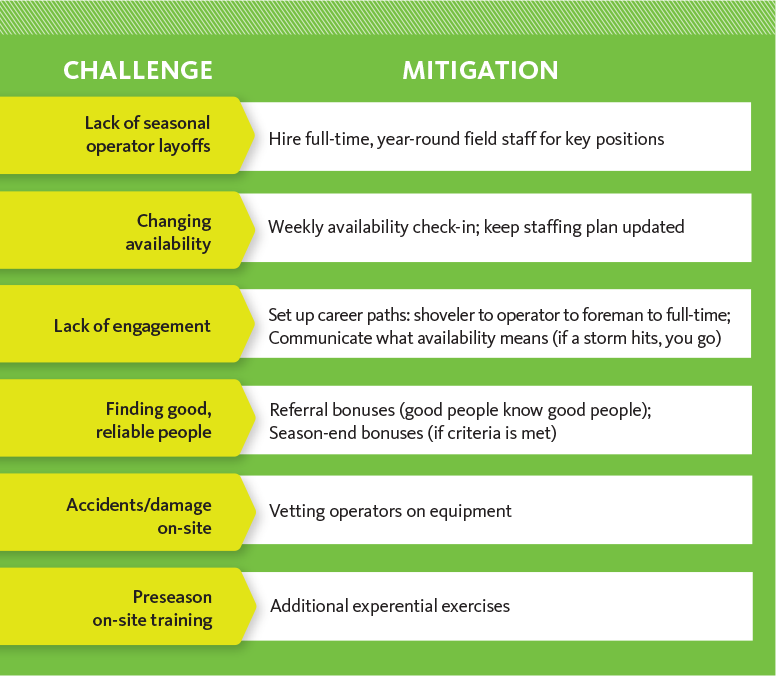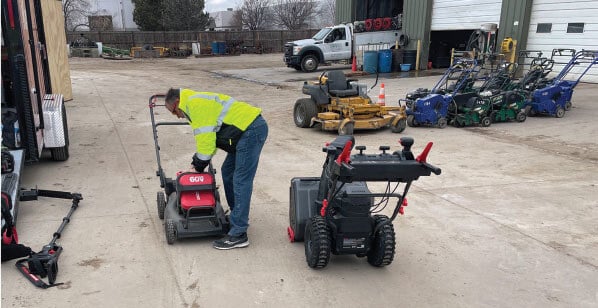I’ve always felt that the snow and ice management business is a lot like the fire department. You want your fire department to have the latest and best equipment; and to be fully staffed with well-trained, highly dedicated firefighters who are ready to go at a moment’s notice. You happily pay your taxes to support your local fire department so that you can have peace of mind that if you need them, they will do everything possible to save your family and property. Yet, you hope they never need to show up at your house.
Part of our job is to help our customers understand that thought process. If they only pay for snow and ice management at the time services are delivered, then it may be difficult for you to have the best equipment, the best-trained staff, and to be as ready as possible.
-1.png?width=300&height=300&name=Untitled%20design%20(1)-1.png)
If you are charging on a per-time, per-occurrence or per-storm basis, then your pricing should be set up such that in a "normal" or average winter, you are covering your fixed and variable costs and making a reasonable profit.
And that would be fine if every winter was "normal." Unfortunately, winters tend to swing from one extreme to the other. With per-basis contracts, the customer "wins" and saves money in a light winter. That means the contractor loses, since you don’t even cover your fixed costs. The variable costs take care of themselves since you didn’t incur the costs if you did not do the work.
Conversely, in a heavy winter the contractor "wins" and makes extra money since a portion of the per-basis charges covers your fixed costs. Once you reach the "normal" level, your fixed costs are 100% covered and anything above that is cash in your pocket.
The end result is that unless your market area has a "normal" winter, someone will win and someone will lose. As professional snow removal experts, our job is to reduce or eliminate this risk by creating a win-win contract relationship with our clients.
Tiered approach
The best way to guarantee a winwin contract is to offer snow services on a tiered seasonal contract. If you have never heard of a tiered seasonal contract (sometimes known as a hybrid contract), you are not alone since it is the least-used type in most contractors’ toolboxes. How does it work?
- Set up tiers that represent possible winter outcomes in the market area for the jobsite. I recommend five tiers: low, medium-low, medium, mediumhigh and high.
- Establish an annual snowfall total for each tier.
- Determine the method for measuring the total snowfall for the market area.
Pricing structure
Each tier comes with a quoted seasonal price dependent on how much snow falls in the market area.
I have seen two ways to handle payment for this contract model:
1. The customer makes five or six equal monthly payments based on the medium tier. At the end of the season, the customer is billed or credited if the snowfall total is above or below the medium tier. I used this method for years, and it served me well.
Occasionally, the customers don’t even want a refund. They are happy to have a credit on their account or even ask us to perform a new service they otherwise would not have requested in order to use up their credit. Some property managers don’t like to spend any less than they have in the budget for fear they won’t get it back in next year’s budget. This can be good for the contractor.
2. Invoice the customer in five or six equal monthly payments based on the lowest tier and when the snow totals exceed that level, the customer is invoiced for the amount due to get them to the next level. These catch-up payments can be a lump sum or spread out over the remaining months. While this method works fine, I like the first method because there is only one adjusting invoice at the end of the season, and you never need to change invoices you have already set up in your system for future months.
Cover your bases
Using a tiered seasonal contract does not automatically create a win-win relationship. You need to price the work so that no matter what kind of winter season takes place, you have 100% of your fixed costs covered.
The difference between the tiers should be the amount of variable costs you expect to incur based on that level of snowfall. This can be the tricky if you don’t have an estimating tool that helps you easily account for the fixed and variable costs, as well as the profit associated with each contract.
You should make a percentage of your profit on top of the fixed costs and from your variable costs. Those percentages will vary by company based on your setup and goals.
Many potential customers see the tiered seasonal contract as being very fair to both parties. It is a great way to convert a customer who is used to paying per-basis to a seasonal contract so that you can cover your costs regardless of the winter Mother Nature throws your way.
Snow contractor costs
Fixed Costs
Fixed costs include all costs the business incurs related to snow operations as well as general business operations. These costs don’t change very much regardless of a light or heavy winter.
- Truck and equipment payments
- Routine equipment maintenance
- Office and management team salaries
- Preseason preparation and training
- Rent, all facility costs
- Electricity and other utilities
- Insurance
- Technology (computers, phones, radios, snow cameras, data systems, etc.)
- All overhead and administrative expenses
Variable costs
Variable costs include expenses directly tied to performing the snow and ice management services. These costs go up with each event, so they are much higher in a busy winter and much lower in a light winter.
- Labor
- Labor burden
- Subcontractors
- Fuel
- Materials
- Storm repairs
Rick Kier of Forge Ahead Consulting was president and owner of Pro Scapes Inc. in Syracuse, NY, for 41 years before he sold the business. He now consults for snow and landscape companies across the US and Canada. Contact him at rick@rickkier.com.



